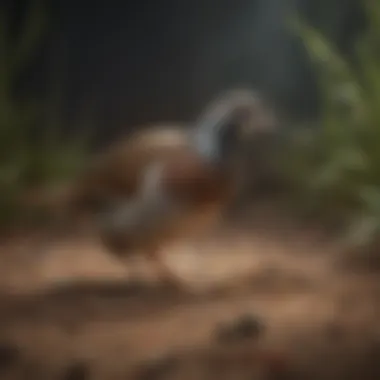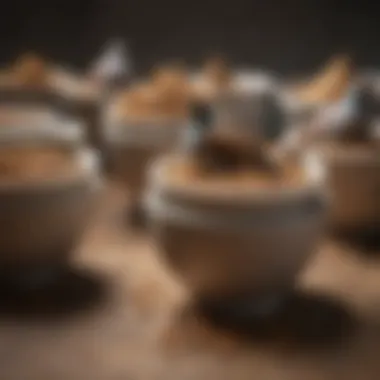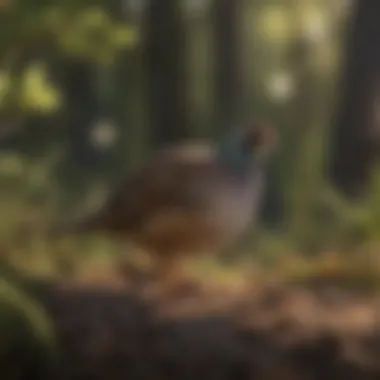A Comprehensive Guide to Quail Feed Nutrition


Intro
Quail are small, ground-dwelling birds that have captivated both wildlife enthusiasts and commercial breeders. Their nutritional needs are specific and essential for healthy growth, egg production, and overall well-being. Understanding these needs is critical for anyone who wishes to raise quail successfully. This guide will dissect the various aspects of quail feed, emphasizing nutritional requirements, feeds available in the market, and feeding practices that promote optimal health and productivity.
Fascinating Facts About the Animal
Unique Characteristics
Quail belong to the family Phasianidae, which also includes pheasants and partridges. These birds possess some unique characteristics that set them apart.
- Size: Generally, quail are small, weighing between 4 to 10 ounces.
- Coloration: Many species exhibit distinctive plumage patterns that provide camouflage in their natural habitat.
- Egg Production: Quail are known for rapid egg-laying capabilities. A single female may lay up to 300 eggs in a single year.
Extraordinary Abilities
Quail are remarkable for several reasons:
- Flight: Unlike many birds that prefer to stay grounded, quail can swiftly fly short distances, often reaching speeds of up to 20 miles per hour.
- Vocalization: They are also vocal and communicate through distinct calls, which play a crucial role in their social interactions.
Behavior and Habitat
Natural Habitats
Quail are found in diverse environments. They thrive in:
- Grasslands: Open areas with adequate cover to hide from predators.
- Scrublands: Thickets provide shelter and nesting materials.
- Agricultural Lands: Quail often inhabit crop fields, benefiting from the seeds available.
Social Structures
Grouping behavior is important in quail. They tend to live in coveys, typically consisting of 10 to 20 individuals. This social structure aids in protection and efficient foraging.
Recent Scientific Discoveries
Latest Research Findings
Recent studies have shown the importance of specific nutrients in quail diets. Research indicates that optimal levels of protein and fiber are crucial for growth and egg-laying performance. Further studies highlight the role of vitamin D in enhancing bone health among quail populations.
Breakthroughs in Animal Biology
Advancements in genomics have revealed how quail genetics influence their feeding habits. This understanding is paving the way for improved feeding strategies tailored to individual quail strains.
Cultural Significance
Animals in Folklore
Quail have been part of human culture for centuries. They appear in various myths and legends, often symbolizing loyalty and the cyclical nature of life due to their prolific breeding habits.
Influence on Art and Literature
Historically, quail have inspired artworks and writings. They are often depicted in paintings that explore nature and simplicity, reflecting the beauty found in small, intricate beings.
Preamble to Quail Feeding
Understanding the feeding habits of quail is essential for anyone involved in their breeding or care. Proper nutrition significantly impacts their growth, reproductive health, and overall well-being. Quail have unique dietary requirements that, if met, can enhance their longevity and productivity. Failing to provide adequate nutrition may lead to various health issues and reduced egg production.
Importance of Proper Nutrition
Nutrition plays a crucial role in the life of quail. These birds require a balanced diet containing proteins, fats, carbohydrates, vitamins, and minerals. Each component serves a purpose:


- Proteins are vital for growth and egg production.
- Fats provide energy necessary for activities and maintaining body temperature.
- Carbohydrates support daily activities and aid in digestion.
- Vitamins and minerals maintain various bodily functions, such as immune system support.
A well-formulated diet can lead to healthier quail with better metabolic functions. Moreover, providing the right nutrients can prevent common illnesses, ensuring that quail not only survive but thrive in their environments.
Overview of Quail Species
There are several species of quail, each with specific nutritional needs. For example, the Coturnix quail is a popular choice for egg production and meat. This species stands out due to its rapid growth rate and adaptability to various feeding practices. On the other hand, the Bobwhite quail is more commonly found in the wild and has different dietary habits when compared to domesticated breeds.
Captive quail, such as those raised for eggs or meat, benefit from a controlled diet that mimics their natural feeding patterns. Understanding the specific species and their habitat is important for tailoring their nutritional needs effectively. Proper knowledge of quail species also helps in aligning feeding practices with their behavioral needs, promoting a healthier living environment.
Nutritional Requirements for Quail
Understanding the nutritional requirements for quail is essential for anyone involved in breeding or caring for these birds. Proper nutrition affects not only their growth but also their reproduction, egg production, and overall health. Ensuring quails receive the right balance of nutrients can enhance their productivity and longevity.
An optimal diet typically consists of macronutrients and micronutrients, both of which play distinct yet complementary roles in a quail's diet. Furthermore, adequate hydration is crucial in maintaining the physiological functions of these birds, especially in fluctuating environmental conditions.
Macronutrients: Proteins, Fats, and Carbohydrates
Macronutrients are the primary components of a quail's diet and include proteins, fats, and carbohydrates.
- Proteins are critical for muscle development, feather production, and overall growth. Young quails need more protein than adult birds. Typically, a diet including about 20-25% protein is recommended for growing quails. Sources can include soybean meal, fish meal, and certain grains.
- Fats are more energy-dense than proteins or carbohydrates. They should make up about 5-10% of the diet. Fats help in nutrient absorption and provide essential fatty acids. Common sources include vegetable oils and animal fats.
- Carbohydrates serve as the main energy source. They should constitute around 55-65% of the total diet. Whole grains like corn and wheat are excellent carbohydrate sources, providing energy necessary for daily activities and thermal regulation.
Micronutrients: Vitamins and Minerals
Micronutrients encompass vitamins and minerals, which, despite being required in smaller quantities, are vital to quail health.
- Vitamins like A, D, E, and K play roles in vision, bone health, and metabolic processes. Deficiencies can lead to serious health problems, including stunted growth or poor egg production.
- Minerals such as calcium, phosphorus, and sodium are equally important. Calcium is essential for egg-laying hens to produce shells, while phosphorus is crucial for skeletal health. A balanced mineral supplementation may be necessary depending on the base feed used.
Water Intake Considerations
Water is an often-overlooked component of quail nutrition. It is fundamental for metabolic processes, digestion, and thermoregulation. Quails require a constant supply of clean, fresh water. During warmer months, or in high-stress conditions, water intake may increase significantly.
It is advisable to monitor water supply carefully and adjust as necessary, especially when transitioning from dry feed to moistened or wet feeds. Dehydration not only affects health but can also impact feeding behavior and growth rates.
Regular access to water is as essential as a well-balanced diet for maintaining quail health and productivity.
In summary, an understanding of nutritional requirements for quail helps ensure their optimal growth and production. Focusing on macronutrients like proteins, fats, and carbohydrates, along with sufficient vitamins and minerals, sets the foundation for their overall development and wellbeing.
Types of Quail Feed
Understanding the types of quail feed is critical for any quail breeder or enthusiast. Proper feed selection impacts the health, growth, and egg production of quail. Each type of feed serves distinct purposes and suits different breeding goals.
The choice between commercial feeds, homemade recipes, and organic options can affect the nutritional profile and overall health of quail. Below, we will outline each category in detail, emphasizing their characteristics and benefits.
Commercial Feed Options
Commercially available quail feeds are convenient and scientifically formulated to meet the dietary requirements of quail. These feeds come in various formulations tailored for different life stages, such as starter, grower, and layer feeds. They often contain balanced levels of protein, vitamins, and minerals, which are essential for optimal growth and production.
Using commercial feeds can save time and effort, as they eliminate the guesswork in feeding. However, it is crucial to select a reputable brand to ensure quality ingredients. A downside might be the cost, as these feeds can be pricier than homemade options.
Homemade Feed Recipes
Creating homemade feed recipes allows for greater control over the ingredients and can be tailored to meet the specific needs of your quail. Homemade feed can embrace a variety of ingredients that not only nourish but also provide freshness.
Ingredients
In homemade quail feed, the ingredients usually include grains, seeds, legumes, and other nutrient-rich components. Common grains are corn, wheat, and barley, providing essential carbohydrates.
A beneficial aspect of using diverse ingredients is that it promotes a more varied diet for quail. For example, incorporating flaxseed adds omega-3 fatty acids, which can improve overall health.


However, care must be taken to ensure that these ingredients fulfill their nutritional roles. Balancing proteins, fats, and carbohydrates is important. Some breeders may struggle with this balance, possibly leading to deficiencies.
Preparation Method
The preparation method for homemade feed involves mixing the chosen ingredients in proper proportions. This process allows breeders to ensure uniform distribution of nutrients. One popular approach is to grind grains into a fine powder, making it easier for quail to digest.
Preparation offers advantages, such as fresher feed without preservatives, but requires time and commitment. Ensure the feed is stored properly to avoid spoilage.
Organic and Specialty Feeds
Organic feeds often prioritize health and sustainability. These feeds are made from ingredients grown without the use of pesticides or synthetic fertilizers. Choosing organic options can attract health-conscious breeders and those concerned about food safety. Specialty feeds might cater to specific needs, such as high-protein diets for meat production or low-stress feeds for breeding.
Feeding Practices for Quail
Feeding practices play a crucial role in the overall health and productivity of quail. Ensuring quail receive the right amount of feed, at appropriate intervals, can greatly influence their growth rate, reproductive success, and overall well-being. A systematic approach in feeding practices also aids in reducing waste and promoting efficient feeding behavior. Poor feeding routines can lead to several health complications, including obesity and deficiencies.
Feeding Frequency and Portion Sizes
The frequency of feeding quail depends on their age, size, and production purpose. Generally, adult quail benefit from being fed twice a day. This schedule allows for optimal digestion and nutrient absorption. The portion size should be based on the expected consumption, which can vary from 20 to 25 grams of pellets per bird daily.
To effectively manage portion sizes, it is advisable to observe quail's eating behavior. Empty feeders can indicate too little feed, while excessive feed left behind may suggest the portions are too large. Gradually adjusting the amount offered can help find the ideal balance.
Tips for Feeding Young Quail
Feeding young quail requires special attention due to their delicate nature. Newly hatched quail, often referred to as chicks, need access to high-quality starter feed that is formulated specifically for their needs. This type of feed typically contains higher protein levels, around 28-30%, to support their rapid growth.
Chicks should be offered small amounts of feed frequently throughout the day. A schedule of 4 to 5 feedings can ensure they receive adequate nutrition. Hygiene is also paramount; maintaining clean feeders prevents contamination and disease.
It is also beneficial to provide a shallow water source and a source of grit. Grit aids in digestion, especially for those consuming whole seeds or grains.
Managing Feed Waste
Feeding practices should include strategies for minimizing waste. Discarded feed can be costly and attracts unwanted pests. To manage feed waste effectively, the following strategies can be implemented:
- Proper feeder design: Use feeders that limit spillage. This may involve using trough feeders or hoppers that allow birds to feed without creating a mess.
- Portion control: By providing appropriate portion sizes at each feeding, waste can be reduced significantly. Regularly monitor feed levels and adjust accordingly.
- Monitoring feeding behavior: Observe the quail's feeding patterns to identify any issues with waste. If excess feed is consistently present, reassess the portion sizes or feeder design.
By implementing better feeding practices, not only can you reduce feed wastage but also significantly enhance the health and well-being of your quail.
Establishing efficient feeding practices is essential to quail management. By understanding and addressing specific feeding needs, one can optimize health and productivity while minimizing waste.
Common Challenges in Quail Nutrition
Feeding quail involves various challenges that can affect their health and productivity. Understanding these challenges is crucial for anyone who raises quail, whether for personal enjoyment or commercial purposes. This section explores the common hurdles in quail nutrition, focusing on identifying nutritional deficiencies and addressing overfeeding issues. These elements are significant as they not only impact the well-being of the birds but also determine their capacity for egg laying, growth, and overall vitality.
Identifying Nutritional Deficiencies
Nutritional deficiencies can manifest in various ways among quail. Symptoms may include poor feather quality, reduced egg production, and lethargy. The right balance of macronutrients and micronutrients is vital for their health. Some common deficiencies include:
- Protein: Essential for growth and egg production. Insufficient protein can lead to stunted growth and lower egg rates.
- Vitamins: Lack of specific vitamins, such as A, D, and E, can result in issues like weak bones, reproductive failure, and immune problems.
- Minerals: Calcium and phosphorus are crucial for shell formation in eggs. A deficiency can lead to thin eggshells or reproductive issues.
To avoid these issues, regular health checks and feed analysis are recommended. If deficiencies are suspected, provide a well-rounded diet and consider supplements until balance is restored. An assessment from a veterinary nutritionist can also be beneficial.
Addressing Overfeeding Issues
While ensuring that quail receive the necessary nutrients is vital, overfeeding presents its own set of complications. Excessive food intake can lead to obesity, which in turn causes health conditions like fatty liver disease. Overfeeding can also result in waste management problems and increased feeding costs. To mitigate these issues, consider these strategies:
- Portion Control: Offer pre-measured amounts based on the quail's age and breed, adjusting as they grow or their production levels change.
- Monitor Feed Types: Opt for nutritionally balanced feeds and avoid high-calorie treats in excess.
- Observe Behavior: Keep an eye on your quail to ensure they are consuming their food steadily without excessive overeating.


The Role of Supplements in Quail Feed
Supplements play a vital role in optimizing the diet of quail. These birds, much like other domesticated animals, require a balanced diet to support their growth, health, and productivity. While commercial and homemade feeds can provide the essential nutrients, there are instances when additional nutrients become necessary to fill gaps or address specific health concerns. Thus, understanding the role of supplements allows enthusiasts and breeders to fine-tune the diets of their quail, ensuring they receive adequate nutrition throughout their lives.
Types of Supplements Available
There are numerous types of supplements tailored for quail feed. These supplements can be broadly categorized as follows:
- Vitamins: Vitamins A, D, E, and various B vitamins are crucial for metabolic functions, immune response, and overall health. Vitamin A is particularly important for vision and reproduction.
- Minerals: Minerals like calcium, phosphorus, and salt help maintain bone health and egg production. Calcium is especially vital for laying hens.
- Amino Acids: Essential amino acids such as methionine and lysine can be supplemented to support muscle development and feather quality.
- Probiotics: These are live microorganisms that can enhance gut health, improve digestion, and boost the immune system.
- Fatty Acids: Omega-3 and omega-6 fatty acids can support skin health and overall well-being. They aid in reducing stress and have anti-inflammatory properties.
When to Use Supplements
Using supplements requires careful consideration of the quail's life stage and overall health. Here are some scenarios when supplements should be utilized:
- During Growth Phases: Young quail have higher nutritional needs. Supplements can ensure they meet their requirements for rapid growth and development.
- Post-Molt Period: After molting, quail may need extra nutrients to replenish their feathers and restore energy levels.
- Breeding Season: Breeding quail benefit from enhanced nutrition to support reproductive health. Vitamins and minerals can improve egg production and hatch success.
- Disease Recovery: Supplementing the diet during recovery from illness can bolster the immune system and help with faster recovery.
- Stress Management: Quail experiencing environmental changes or stressors can benefit from probiotics and fatty acids, which may help improve their resilience.
"The right supplements can fill dietary gaps, enhance health, and ensure optimal productivity in quail."
Tailoring the use of supplements according to these factors can lead to improved outcomes in quail management. Careful observation and knowledge of the birds' needs are essential for maximizing the benefits of any supplemental feeding.
Environmental Considerations
Understanding environmental considerations is essential in quail feeding. The quality of the environment in which quail live directly affects their health and productivity. Proper management of these factors can enhance feed efficiency and improve overall wellbeing.
Optimal Feeding Conditions
Optimal feeding conditions play a critical role in maximizing the growth and egg production of quail. One major aspect is the cleanliness of the feeding area. Ensuring that feed and water containers are clean helps reduce the risk of disease.
In addition, providing a comfortable temperature range is crucial. Quail thrive in moderate temperature conditions, so maintaining an environment that is neither too hot nor too cold will help them consume feed optimally. Ventilation is another important factor. Proper airflow prevents ammonia buildup from droppings, creating a healthier habitat.
Light exposure is another element to consider. Quail require a specific light cycle for best results in growth and egg production. Typically, around 14-16 hours of light per day can stimulate better feeding behavior and overall productivity.
To sum up, pay attention to cleanliness, temperature, ventilation, and light exposure to create the best feeding conditions for your quail.
Seasonal Feeding Adjustments
Seasonal feeding adjustments are crucial to adapting quail care for changing environmental conditions. In winter, for example, quail may require additional energy to maintain body temperature. This means increasing the caloric density of their diet. Choosing high-energy grains during colder months can help meet these heightened energy needs.
In contrast, during warmer months, quail might be less active due to heat stress. Reducing feed portions while ensuring the diet remains nutrient-rich can minimize waste. Adding electrolyte supplements during extreme heat can help keep quail hydrated and support their health.
Additionally, the availability of natural food sources can influence the feeding strategy. In spring, insects become more accessible, providing an excellent protein source. Reducing commercial feed during this time may be beneficial since wild foraging can supplement their diet.
Overall, adapting feed types and quantities according to the seasons ensures the quail’s needs are met, leading to better health and production. Adjusting to environmental changes will contribute significantly to effective quail management.
The End and Recommendations
In the pursuit of optimal quail health and productivity, understanding the nutritional needs and best feeding practices is paramount. This article has delved into the intricacies of quail nutrition, highlighting how specific dietary requirements influence overall wellbeing. It is crucial that both enthusiasts and breeders take the time to adjust their feeding strategies based on the insights provided.
- Balance of Nutrients: Every quail species has unique requirements. Identifying the right ratio of proteins, fats, carbohydrates, vitamins, and minerals is essential. An unbalanced diet can lead to growth issues and reduced egg production.
- Types of Feed: The guide has outlined various feed options from commercial feeds to homemade recipes. Each type plays a role in meeting quail dietary needs. Choosing the right feed not only ensures health benefits but also affects temperament and productivity.
- Feeding Practices: Regular monitoring of feeding schedules and portion sizes is vital. Implementing the best practices discussed, such as managing waste and adapting to seasonal changes in feeding habits, will encourage efficient feeding behavior among quail.
Benefits of Proper Quail Feeding
- Enhanced Health: Proper nutrition leads to a robust immune system and fewer diseases.
- Improved Production: Meeting dietary needs translates directly into higher egg yield and quality.
- Better Behavioral Traits: A well-nourished quail is typically more adaptable and less aggressive.
Considerations for Implementation
- Observation: Regularly observe quail for signs of dietary deficiencies such as poor feathers or lethargy.
- Adjustments: Feeding practices should be adjusted based on environmental conditions and quail development stages.
Final Thoughts on Quail Feeding
Understanding and applying sound feeding practices is vital for anyone interested in keeping quail. The nuances of their dietary needs can't be overstated. A commitment to learning about these needs can yield substantial rewards, both in terms of health and productivity. Moving forward, it is recommended to continue seeking knowledge, sharing experiences, and adjusting practices to promote the well-being of these birds. The journey of nourishment should always be informed and adaptive.
"Successful quail feeding not only sustains the birds but also enhances their lifecycle and egg production."
By recognizing these elements, breeders and families can ensure they are providing their birds with optimal care. The insights and recommendations outlined here aim to establish a foundation for further exploration into quail nutrition.







